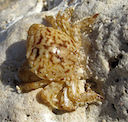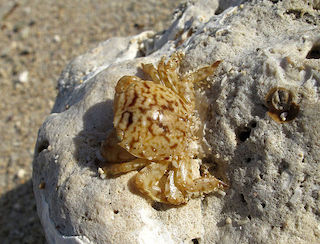 This small crab species is an occasional visitor to Cornwall’s shoreline, brought here by storms and strong currents, often in the company of Goose Barnacles. They can sometimes be spotted on The Lizard.
This small crab species is an occasional visitor to Cornwall’s shoreline, brought here by storms and strong currents, often in the company of Goose Barnacles. They can sometimes be spotted on The Lizard.
Photo: Philippe Boujon
Scientific name: Planes minutus
Other common names: Gulfweed Crab
What to look for:
- Colouring and appearance: Fairly small, with large claws relative to carapace length, with hairy-fringed legs. The colour varies from grey to a rich brown, often with a white patch at the front of the carapace.
- Size: A carapace length of no more than 1 to 2 cm.
- Where: Usually western Atlantic, but can occasionally be carried to western coasts of Britain by ocean currents.
 More typically a species of the western Atlantic, Columbus Crabs do occasionally turn up in Cornwall. The first Cornwall record dates from 1845, when one was spotted on the beach close to Falmouth. It seems appropriate that this record relates to a seafaring port; it is possible that the very first record of this tiny crab species was made in 1492 by the great seafarer Christopher Columbus, when he was sailing through the Sargasso Sea. Although this story is not definitely factual, it is of course the reason for Columbus Crab’s common name.
More typically a species of the western Atlantic, Columbus Crabs do occasionally turn up in Cornwall. The first Cornwall record dates from 1845, when one was spotted on the beach close to Falmouth. It seems appropriate that this record relates to a seafaring port; it is possible that the very first record of this tiny crab species was made in 1492 by the great seafarer Christopher Columbus, when he was sailing through the Sargasso Sea. Although this story is not definitely factual, it is of course the reason for Columbus Crab’s common name.
What is it doing here? Well, this crab lives on floating objects, often in association with Goose Barnacles, and so, like the latter, is prone to being carried away from its normal stomping grounds by storms and strong currents. Individuals are sometimes found stowed away beneath the shell of Loggerhead Turtles, where they feed on algae and other matter. Generally, Columbus Crabs eat a wide variety of food, including fish, krill and other small sea creatures.
Columbus Crabs are a pelagic (sea-living) species. Their colouration is assumed to provide camouflage against the Sargassum weed, which is one of their main habitats in their normal range.
Did you know…?
… Columbus Crabs are sprinters, not marathon ‘runners’. They are good swimmers, but only for relatively short distances, although they can keep going for half an hour or so in warmer waters.
Published: February 2016
Author: Amanda Scott
Photos: Philippe Boujon – Don de l' auteur, CC BY-SA 3.0
